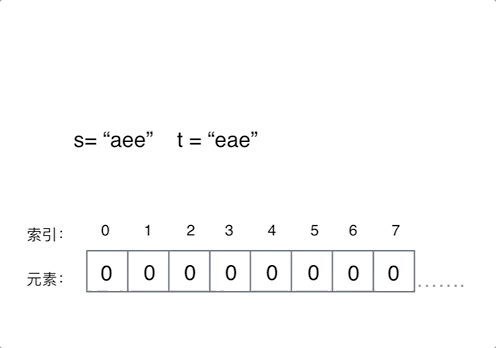参与本项目,贡献其他语言版本的代码,拥抱开源,让更多学习算法的小伙伴们受益!
数组就是简单的哈希表,但是数组的大小可不是无限开辟的
给定两个字符串 s 和 t ,编写一个函数来判断 t 是否是 s 的字母异位词。
示例 1: 输入: s = "anagram", t = "nagaram" 输出: true
示例 2: 输入: s = "rat", t = "car" 输出: false
说明: 你可以假设字符串只包含小写字母。
《代码随想录》算法视频公开课:学透哈希表,数组使用有技巧!Leetcode:242.有效的字母异位词,相信结合视频再看本篇题解,更有助于大家对本题的理解。
先看暴力的解法,两层for循环,同时还要记录字符是否重复出现,很明显时间复杂度是 O(n^2)。
暴力的方法这里就不做介绍了,直接看一下有没有更优的方式。
数组其实就是一个简单哈希表,而且这道题目中字符串只有小写字符,那么就可以定义一个数组,来记录字符串s里字符出现的次数。
如果对哈希表的理论基础关于数组,set,map不了解的话可以看这篇:关于哈希表,你该了解这些!
需要定义一个多大的数组呢,定一个数组叫做record,大小为26 就可以了,初始化为0,因为字符a到字符z的ASCII也是26个连续的数值。
为了方便举例,判断一下字符串s= "aee", t = "eae"。
操作动画如下:
定义一个数组叫做record用来上记录字符串s里字符出现的次数。
需要把字符映射到数组也就是哈希表的索引下标上,因为字符a到字符z的ASCII是26个连续的数值,所以字符a映射为下标0,相应的字符z映射为下标25。
再遍历 字符串s的时候,只需要将 s[i] - ‘a’ 所在的元素做+1 操作即可,并不需要记住字符a的ASCII,只要求出一个相对数值就可以了。 这样就将字符串s中字符出现的次数,统计出来了。
那看一下如何检查字符串t中是否出现了这些字符,同样在遍历字符串t的时候,对t中出现的字符映射哈希表索引上的数值再做-1的操作。
那么最后检查一下,record数组如果有的元素不为零0,说明字符串s和t一定是谁多了字符或者谁少了字符,return false。
最后如果record数组所有元素都为零0,说明字符串s和t是字母异位词,return true。
时间复杂度为O(n),空间上因为定义是的一个常量大小的辅助数组,所以空间复杂度为O(1)。
C++ 代码如下:
class Solution {
public:
bool isAnagram(string s, string t) {
int record[26] = {0};
for (int i = 0; i < s.size(); i++) {
// 并不需要记住字符a的ASCII,只要求出一个相对数值就可以了
record[s[i] - 'a']++;
}
for (int i = 0; i < t.size(); i++) {
record[t[i] - 'a']--;
}
for (int i = 0; i < 26; i++) {
if (record[i] != 0) {
// record数组如果有的元素不为零0,说明字符串s和t 一定是谁多了字符或者谁少了字符。
return false;
}
}
// record数组所有元素都为零0,说明字符串s和t是字母异位词
return true;
}
};- 时间复杂度: O(n)
- 空间复杂度: O(1)
/**
* 242. 有效的字母异位词 字典解法
* 时间复杂度O(m+n) 空间复杂度O(1)
*/
class Solution {
public boolean isAnagram(String s, String t) {
int[] record = new int[26];
for (int i = 0; i < s.length(); i++) {
record[s.charAt(i) - 'a']++; // 并不需要记住字符a的ASCII,只要求出一个相对数值就可以了
}
for (int i = 0; i < t.length(); i++) {
record[t.charAt(i) - 'a']--;
}
for (int count: record) {
if (count != 0) { // record数组如果有的元素不为零0,说明字符串s和t 一定是谁多了字符或者谁少了字符。
return false;
}
}
return true; // record数组所有元素都为零0,说明字符串s和t是字母异位词
}
}class Solution:
def isAnagram(self, s: str, t: str) -> bool:
record = [0] * 26
for i in s:
#并不需要记住字符a的ASCII,只要求出一个相对数值就可以了
record[ord(i) - ord("a")] += 1
for i in t:
record[ord(i) - ord("a")] -= 1
for i in range(26):
if record[i] != 0:
#record数组如果有的元素不为零0,说明字符串s和t 一定是谁多了字符或者谁少了字符。
return False
return TruePython写法二(没有使用数组作为哈希表,只是介绍defaultdict这样一种解题思路):
class Solution:
def isAnagram(self, s: str, t: str) -> bool:
from collections import defaultdict
s_dict = defaultdict(int)
t_dict = defaultdict(int)
for x in s:
s_dict[x] += 1
for x in t:
t_dict[x] += 1
return s_dict == t_dictPython写法三(没有使用数组作为哈希表,只是介绍Counter这种更方便的解题思路):
class Solution(object):
def isAnagram(self, s: str, t: str) -> bool:
from collections import Counter
a_count = Counter(s)
b_count = Counter(t)
return a_count == b_countfunc isAnagram(s string, t string) bool {
record := [26]int{}
for _, r := range s {
record[r-rune('a')]++
}
for _, r := range t {
record[r-rune('a')]--
}
return record == [26]int{} // record数组如果有的元素不为零0,说明字符串s和t 一定是谁多了字符或者谁少了字符。
}Go 写法二(只对字符串遍历一次)
func isAnagram(s string, t string) bool {
if len(s) != len(t) {
return false
}
records := [26]int{}
for index := 0; index < len(s); index++ {
if s[index] == t[index] {
continue
}
sCharIndex := s[index] - 'a'
records[sCharIndex]++
tCharIndex := t[index] - 'a'
records[tCharIndex]--
}
for _, record := range records {
if record != 0 {
return false
}
}
return true
}/**
* @param {string} s
* @param {string} t
* @return {boolean}
*/
var isAnagram = function(s, t) {
if(s.length !== t.length) return false;
const resSet = new Array(26).fill(0);
const base = "a".charCodeAt();
for(const i of s) {
resSet[i.charCodeAt() - base]++;
}
for(const i of t) {
if(!resSet[i.charCodeAt() - base]) return false;
resSet[i.charCodeAt() - base]--;
}
return true;
};
var isAnagram = function(s, t) {
if(s.length !== t.length) return false;
let char_count = new Map();
for(let item of s) {
char_count.set(item, (char_count.get(item) || 0) + 1) ;
}
for(let item of t) {
if(!char_count.get(item)) return false;
char_count.set(item, char_count.get(item)-1);
}
return true;
};function isAnagram(s: string, t: string): boolean {
if (s.length !== t.length) return false;
let helperArr: number[] = new Array(26).fill(0);
let pivot: number = 'a'.charCodeAt(0);
for (let i = 0, length = s.length; i < length; i++) {
helperArr[s.charCodeAt(i) - pivot]++;
helperArr[t.charCodeAt(i) - pivot]--;
}
return helperArr.every(i => i === 0);
};func isAnagram(_ s: String, _ t: String) -> Bool {
if s.count != t.count {
return false
}
var record = Array(repeating: 0, count: 26)
let aUnicodeScalar = "a".unicodeScalars.first!.value
for c in s.unicodeScalars {
record[Int(c.value - aUnicodeScalar)] += 1
}
for c in t.unicodeScalars {
record[Int(c.value - aUnicodeScalar)] -= 1
}
for value in record {
if value != 0 {
return false
}
}
return true
}class Solution {
/**
* @param String $s
* @param String $t
* @return Boolean
*/
function isAnagram($s, $t) {
if (strlen($s) != strlen($t)) {
return false;
}
$table = [];
for ($i = 0; $i < strlen($s); $i++) {
if (!isset($table[$s[$i]])) {
$table[$s[$i]] = 1;
} else {
$table[$s[$i]]++;
}
if (!isset($table[$t[$i]])) {
$table[$t[$i]] = -1;
} else {
$table[$t[$i]]--;
}
}
foreach ($table as $record) {
if ($record != 0) {
return false;
}
}
return true;
}
}impl Solution {
pub fn is_anagram(s: String, t: String) -> bool {
let mut record = vec![0; 26];
let baseChar = 'a';
for byte in s.bytes() {
record[byte as usize - baseChar as usize] += 1;
}
for byte in t.bytes() {
record[byte as usize - baseChar as usize] -= 1;
}
record.iter().filter(|x| **x != 0).count() == 0
}
}object Solution {
def isAnagram(s: String, t: String): Boolean = {
// 如果两个字符串的长度不等,直接返回false
if (s.length != t.length) return false
val record = new Array[Int](26) // 记录每个单词出现了多少次
// 遍历字符串,对于s字符串单词对应的记录+=1,t字符串对应的记录-=1
for (i <- 0 until s.length) {
record(s(i) - 97) += 1
record(t(i) - 97) -= 1
}
// 如果不等于则直接返回false
for (i <- 0 until 26) {
if (record(i) != 0) {
return false
}
}
// 如果前面不返回false,说明匹配成功,返回true,return可以省略
true
}
} public bool IsAnagram(string s, string t) {
int sl=s.Length,tl=t.Length;
if(sl!=tl) return false;
int[] a = new int[26];
for(int i = 0; i < sl; i++){
a[s[i] - 'a']++;
a[t[i] - 'a']--;
}
foreach (int i in a)
{
if (i != 0)
return false;
}
return true;
}bool isAnagram(char* s, char* t) {
int len1 = strlen(s), len2 = strlen(t);
if (len1 != len2) {
return false;
}
int map1[26] = {0}, map2[26] = {0};
for (int i = 0; i < len1; i++) {
map1[s[i] - 'a'] += 1;
map2[t[i] - 'a'] += 1;
}
for (int i = 0; i < 26; i++) {
if (map1[i] != map2[i]) {
return false;
}
}
return true;
}

